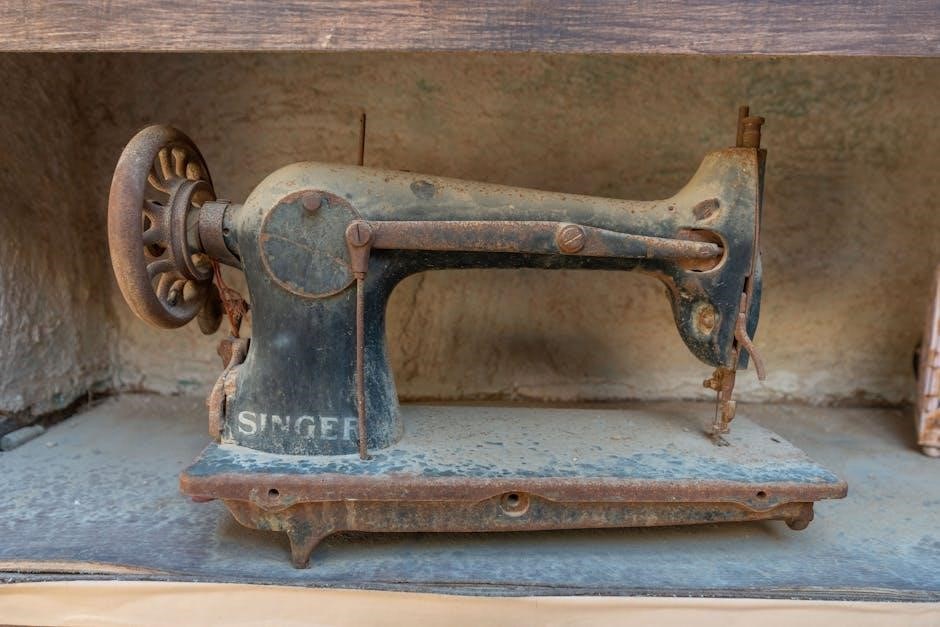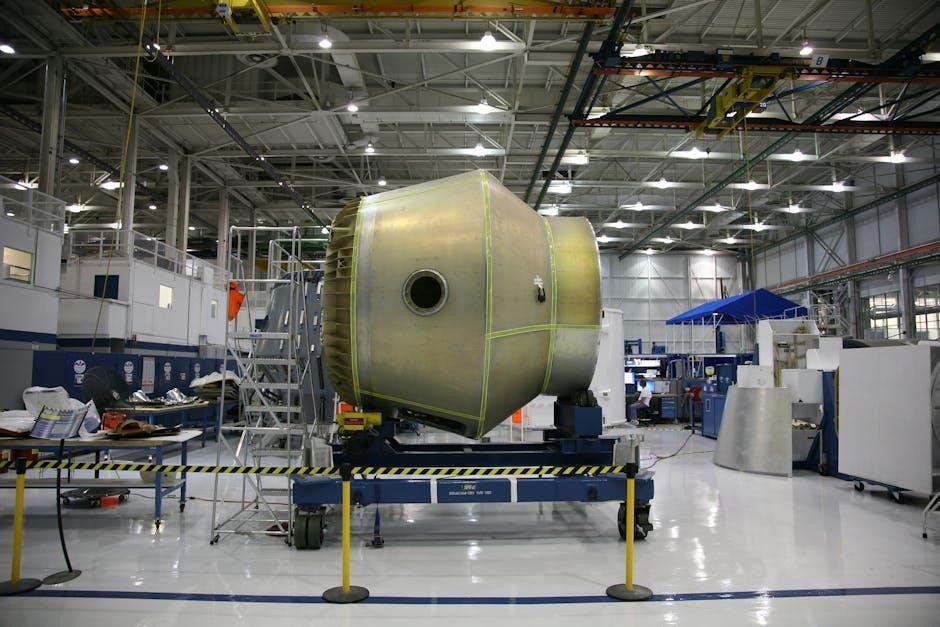Singer Heavy Duty 4411 Sewing Machine Manual: A Comprehensive Guide
Welcome to your ultimate resource for mastering the Singer 4411 Heavy Duty sewing machine! This comprehensive guide serves as your roadmap to unlocking the full potential of your machine. Learn to confidently tackle any sewing project, big or small, with ease and precision.
The Singer 4411 Heavy Duty sewing machine is engineered for reliability and efficiency, designed to tackle various sewing tasks, from everyday mending to heavy-duty projects involving denim and canvas. Its robust motor delivers 60% more power compared to standard machines, ensuring smooth and consistent stitching through thick fabrics. This machine is perfect for both beginners and experienced sewers.
The 4411 boasts a high sewing speed, saving you valuable time on larger projects. A stainless-steel bedplate facilitates smooth fabric flow, while the heavy-duty interior metal frame guarantees skip-free sewing. The top drop-in bobbin system allows for easy monitoring of thread supply, preventing unexpected interruptions mid-seam.
Its versatile stitch options provide flexibility for various sewing needs. Understanding the machine’s features and how to use them properly is crucial for optimal performance. This section will guide you through the key aspects of the Singer 4411, providing a solid foundation for your sewing journey. Whether you are a novice or a seasoned pro, knowing your machine is the first step towards sewing success.
Overview of Manual Contents

This comprehensive manual is designed to guide you through every aspect of using your Singer 4411 Heavy Duty sewing machine. It begins with essential setup instructions, covering everything from unpacking your machine to understanding its various components and their functions. You’ll find detailed, step-by-step guidance on threading the needle and bobbin, ensuring proper setup for successful sewing.
The manual delves into understanding the stitch settings and adjustments, explaining how to select the appropriate stitch for your project and fine-tune settings for optimal results. It also covers adjusting presser foot pressure, which is crucial for handling different fabric weights and thicknesses. Troubleshooting tips are included to help you resolve common issues and keep your machine running smoothly.
Furthermore, you’ll find essential maintenance and care instructions to prolong the life of your machine. An overview of available accessories and parts will introduce you to tools that can enhance your sewing experience. Finally, the manual provides instructions on how to download and access the manual in digital format, ensuring you always have it at your fingertips. This manual is your key to unlocking the full potential of your Singer 4411.
Setting Up Your Singer 4411
Getting your Singer 4411 Heavy Duty ready for action is a straightforward process. Start by carefully unpacking your sewing machine and identifying all included accessories. Place the machine on a stable, flat surface with ample workspace. Ensure the power switch is in the “off” position before connecting the power cord to both the machine and a grounded electrical outlet.
Next, familiarize yourself with the machine’s components, including the bobbin winder, thread guides, tension dial, stitch selector dial, and presser foot lever. Understanding these parts is crucial for proper operation. Install the appropriate needle for your intended fabric type, ensuring it is securely in place.

Before you begin sewing, it’s essential to wind a bobbin with your chosen thread. Follow the manual’s instructions for properly winding the bobbin, ensuring it is evenly filled. Once the bobbin is wound, you’re ready to move on to threading the machine. These initial setup steps are vital for achieving optimal performance and preventing common sewing issues, so take your time and follow the instructions carefully. A correctly set-up machine is a happy machine!
Threading the Needle and Bobbin
Threading the Singer 4411 Heavy Duty is a crucial skill for any sewer. Start by raising the presser foot to release tension on the thread. Place your spool of thread on the spool pin, securing it with the spool cap. Follow the numbered diagram on the machine, guiding the thread through each thread guide, ensuring it is properly seated in each location.
Next, thread the tension disc, making sure the thread goes between the discs for proper tension control. Continue guiding the thread down to the take-up lever, threading it from right to left. Then, guide the thread down to the needle area and thread the needle from front to back.
For the bobbin, first, insert the wound bobbin into the bobbin case, ensuring it rotates in the correct direction (usually counter-clockwise). Pull the bobbin thread through the slot in the bobbin case. Place the bobbin case into the machine, making sure it clicks into place. Finally, raise the needle to its highest position and use the handwheel to bring the bobbin thread up through the needle plate. Now you’re ready to sew!
Understanding Stitch Settings and Adjustments
The Singer 4411 Heavy Duty offers a variety of stitch options and adjustments to suit different sewing needs. Familiarizing yourself with these settings is key to achieving professional-looking results. The stitch selector dial allows you to choose from various stitch patterns, including straight stitch, zigzag, and decorative stitches. Each stitch has a specific purpose, so experiment to find the best option for your project.
The stitch length dial controls the length of each stitch. A shorter stitch length is ideal for delicate fabrics or creating fine details, while a longer stitch length is suitable for heavier fabrics or basting. The stitch width dial adjusts the width of zigzag stitches. Wider stitches are great for creating satin stitches or decorative effects, while narrower stitches are perfect for buttonholes.
Tension adjustment is also crucial. Proper tension ensures balanced stitches. If your stitches are looping on the top or bottom, adjust the tension dial accordingly. Always test your settings on a scrap piece of fabric before starting your project to ensure optimal stitch quality.
Adjusting Presser Foot Pressure
The Singer 4411 Heavy Duty sewing machine features an adjustable presser foot pressure, a vital setting for accommodating various fabric thicknesses. The presser foot pressure determines how firmly the fabric is held against the feed dogs during sewing. Adjusting this pressure ensures smooth and even feeding of the fabric, preventing puckering, slipping, or skipped stitches.
For lightweight fabrics like silk or chiffon, reduce the presser foot pressure to prevent the fabric from being marked or stretched. Loosen the pressure by turning the presser adjusting screw counter-clockwise. Conversely, for heavyweight fabrics like denim or canvas, increase the presser foot pressure to provide a firm grip and ensure consistent feeding. Tighten the pressure by turning the screw clockwise.

To test the presser foot pressure, sew a sample piece of fabric. If the fabric feeds smoothly and the stitches are even, the pressure is correct. If the fabric puckers or slips, adjust the pressure accordingly until you achieve optimal results. Refer to your manual for the exact location of the presser foot adjusting screw on your Singer 4411 model.
Troubleshooting Common Issues
Even with a robust machine like the Singer 4411 Heavy Duty, occasional issues may arise. This section addresses common problems and provides solutions to get you back to sewing quickly. If you encounter thread breakage, ensure the machine is properly threaded, the needle is correctly inserted, and the thread tension is appropriately adjusted. Use quality thread suitable for your fabric.
Skipped stitches can often be resolved by changing the needle to a new one, ensuring it’s the correct type and size for the fabric. Also, verify the presser foot is securely attached. For fabric feeding problems, clean the feed dogs and bobbin area to remove lint and debris. Adjust the presser foot pressure as needed.
If the machine is noisy or vibrates excessively, check for loose screws or parts and tighten them. Oiling the machine regularly, as outlined in the maintenance section, can also reduce noise. If the bobbin winder isn’t working, ensure the bobbin is correctly placed and the bobbin winder spindle is engaged properly. For more complex issues, consult a qualified sewing machine technician.
Maintenance and Care Tips
Proper maintenance is crucial for extending the life and performance of your Singer 4411 Heavy Duty. Regularly clean the machine to remove lint and dust accumulation. Use a soft brush to clean the feed dogs, bobbin area, and other accessible parts. Oiling is essential for smooth operation. Apply a few drops of sewing machine oil to the designated points, as indicated in the manual, every few months, or more frequently with heavy use.
Always cover your machine when not in use to protect it from dust and sunlight. Store it in a cool, dry place. Replace needles regularly to maintain stitch quality and prevent damage to fabrics. Use the correct type and size of needle for your sewing project. Inspect the machine periodically for loose screws or parts and tighten them as needed.
If you notice any unusual noises or performance issues, address them promptly to prevent further damage. Consider having your machine professionally serviced annually to ensure it remains in optimal condition. Following these maintenance tips will keep your Singer 4411 Heavy Duty running smoothly for years to come.
Available Accessories and Parts
The Singer 4411 Heavy Duty sewing machine is compatible with a wide range of accessories and parts, enhancing its versatility and functionality. Standard accessories often included are various presser feet, such as the all-purpose foot, zipper foot, buttonhole foot, and button sewing foot. These feet enable you to tackle different sewing tasks with ease. Additional needles, bobbins, and a seam ripper are also commonly included.
For specialized projects, consider purchasing additional accessories like a walking foot for even fabric feeding, a quilting foot for precise stitching, or a blind hem foot for professional-looking hems. Replacement parts, such as bobbins, needles, and feed dogs, are readily available online or at sewing machine retailers.

Explore the available extension tables to provide a larger work surface for quilting or handling bulky projects. Using genuine Singer parts ensures compatibility and optimal performance. Refer to your manual or the Singer website for a complete list of compatible accessories and parts to elevate your sewing experience.
Downloading and Accessing the Manual
Accessing the Singer 4411 Heavy Duty sewing machine manual is easier than ever, thanks to readily available digital resources. If you’ve misplaced your physical copy, numerous online platforms offer downloadable PDF versions. The official Singer website is a primary source, providing manuals for various models, including the 4411.
Simply navigate to the support or downloads section, search for your model number, and download the manual directly to your computer or mobile device. Many third-party websites also host sewing machine manuals, but exercise caution and ensure the source is reputable to avoid downloading potentially harmful files.
Once downloaded, the PDF manual can be viewed on any device with a PDF reader. Consider saving it to a cloud storage service like Google Drive or Dropbox for easy access from anywhere. Some websites also offer online viewing of the manual without requiring a download. This allows you to quickly reference specific sections as needed while you are sewing.